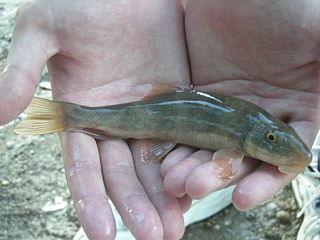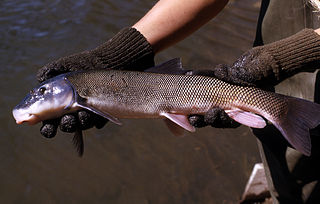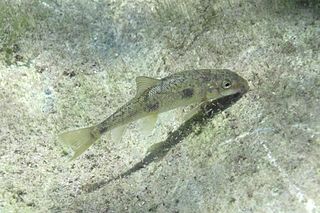
The Virgin River is a tributary of the Colorado River in the U.S. states of Utah, Nevada, and Arizona. The river is about 162 miles (261 km) long. It was designated Utah's first wild and scenic river in 2009, during the centennial celebration of Zion National Park.

The Price River is a 137-mile-long (220 km) southeastward flowing river in Carbon, Utah and Emery counties in eastern Utah. It is a tributary to the Green River, itself a tributary to the Colorado River.

The longnose sucker is a species of cypriniform freshwater fish in the family Catostomidae. It is native to North America from the northern United States to the top of the continent. It is also found in Russia in rivers of eastern Siberia, and this one of only two species of sucker native to Asia.

Catostomus is a genus of fish belonging to the family Catostomidae, commonly known as suckers. This genus of fish usually lives in freshwater basins. Most members of the genus are native to North America, but C. catostomus is also found in Russia.

The mountain sucker is a sucker found throughout western North America, on both sides of the Rocky Mountains, including the upper Missouri River, Columbia River, Sacramento River, and Colorado River. It is not limited to higher altitudes but is known from locations as high as 2,800 m (9,200 ft). It is a slender, streamlined fish typically under 20 cm (8 in) in length. It is generally olive green or brown above, with pale underparts, and breeding males have a lateral red-orange band and fins suffused with the same color. It is mainly herbivorous, feeding on algae and diatoms. Breeding takes place in late spring and early summer in gravelly riffles in small streams.

The Santa Ana sucker is a freshwater ray-finned fish, endemic to California. It is closely related to the mountain sucker and has dark grey upper parts and silvery underparts. It grows to a maximum length of 25 cm (10 in), but most adults are much smaller than this. It feeds on algae, diatoms and detritus on the floor of shallow streams with sand, gravel or cobble bottoms. It is found in only a few streams in southern California, and many of these in the Greater Los Angeles metropolitan area have been restricted to concrete channels. Because of its small area of occupancy and vulnerability, the International Union for Conservation of Nature has rated this fish as "endangered".

The golden redhorse is a species of freshwater fish endemic to Ontario and Manitoba in Canada and the Midwestern, southern, and eastern United States. It lives in calm, often silty or sandy waters in streams, small to large rivers, and lakes.

The Yaqui sucker is a species of ray-finned fish in the family Catostomidae. It is found in the Aridoamerica region of northern Mexico and south-western United States. Catostomus bernardini or Yaqui sucker belongs to the family Catostomidae. The Yaqui sucker is related to the Sonora sucker and could possibly be a subspecies of the Gila sucker.

The beautiful shiner is a species of ray-finned fish in the family Cyprinidae. It is found in Mexico and Arizona and New Mexico in the United States. It is one of 22 species of Cyprinella found in North America.
The Mexican stoneroller is a species of fish native to Arizona and Texas in the United States and parts of adjacent Mexico. It belongs to the carp family, Cyprinidae. The other species in this genus, Campostoma are morphologically similar.

The Sonora Sucker, Catostomus insignis, is a medium-sized catostomid fish with 16 other species in the genus scattered throughout North America. This species is remarkably similar in appearance to the Yaqui Sucker.

Catostomus latipinnis is a North American fish identified by its enlarged lower lips. It belongs to the genus Catostomus, commonly known as suckers. Historically, the flannelmouth sucker ranged in the Colorado River Basin, including parts of Wyoming, Utah, Colorado, New Mexico, Nevada, California, and Arizona; however, this species has been entirely extirpated from the Gila River Basin in Arizona.
The Little Colorado River sucker or Little Colorado sucker is a scientifically undescribed species of North American freshwater fish very similar to the flannelmouth sucker but without the flannelmouth's distinct fleshy lips. The Little Colorado sucker is native to the upper region of the Little Colorado River in Arizona, but was also introduced into the Salt River.
Catostomus discobolus jarrovii is a species of fish only found in Arizona and New Mexico in the United States.

The Modoc sucker is a rare species of freshwater fish native to northern California and southern Oregon. It grows to a length of about 7 in (18 cm) and becomes sexually mature at 4 in (10 cm). It feeds on algae, small invertebrates and detritus, and hides under stones, detritus and overhanging vegetation. It is found in only a few streams and is listed as an endangered species in California and the United States. Conservation measures have been put in place such as fencing the streams in which it lives from livestock. It was previously rated as "endangered" in 1973 by the International Union for Conservation of Nature, but this rating has now been changed to "near threatened", and the U.S. Fish and Wildlife Service removed the Modoc sucker from the federal list of endangered and threatened wildlife in 2016.

The desert sucker or Gila Mountain sucker, is a freshwater species of ray-finned fish in the sucker family, endemic to the Great Basin and the Colorado River Basin in the United States. It inhabits rapids and fast-flowing streams with gravelly bottoms. It is a bi-colored fish with the upper parts olive brown to dark green, and the underparts silvery-tan or yellowish. The head is cylindrical, tapering to a thick-lipped mouth on the underside. This fish can grow to 31 in (79 cm) in Arizona but is generally only about half this size elsewhere. There are three subspecies, found in different river basins, and some authorities allot this species its own genus Pantosteus.

The white sucker is a species of freshwater cypriniform fish inhabiting the upper Midwest and Northeast in North America, but it is also found as far south as Georgia and as far west as New Mexico. The fish is commonly known as a "sucker" due to its fleshy, papillose lips that suck up organic matter and aufwuchs from the bottom of rivers and streams.

The Tahoe sucker is a freshwater cypriniform fish inhabiting the Great Basin region of the Western United States.

The Sacramento sucker is a species of ray-finned fish in the family Catostomidae. It is primarily found in California with some populations extending into Oregon and Nevada. They inhabit a diverse range of habitats from headwater streams to deep lakes to estuaries.The Sacramento sucker scientific name Catostomus occidentalis describes its morphology and origin, respectively, being an inferiorly mouthed (Catostomus) western (occidentalis) species; the name Western sucker has also been used.

The Rio Grande sucker is a North American freshwater fish in the family Catostomidae. It has a typical bottom-feeding phenotype and fills lower trophic levels alongside Rio Grande cutthroat trout and Rio Grande chub species. It is smaller sized in comparison to its other family members, with females being the larger between sexes. Coloration tends to benefit the species due to counter-shading patterns. It is endemic to the Rio Grande basin and was once common throughout. The species has maintained a population in New Mexico, Colorado, Arizona, and Northern Mexico, but has faced challenges from the pressure of non-native species, habitat loss, degradation, and a variety of other aquatic ecosystem changes. There is current pressure from environmental organizations to federally list the species as threatened or endangered.

















